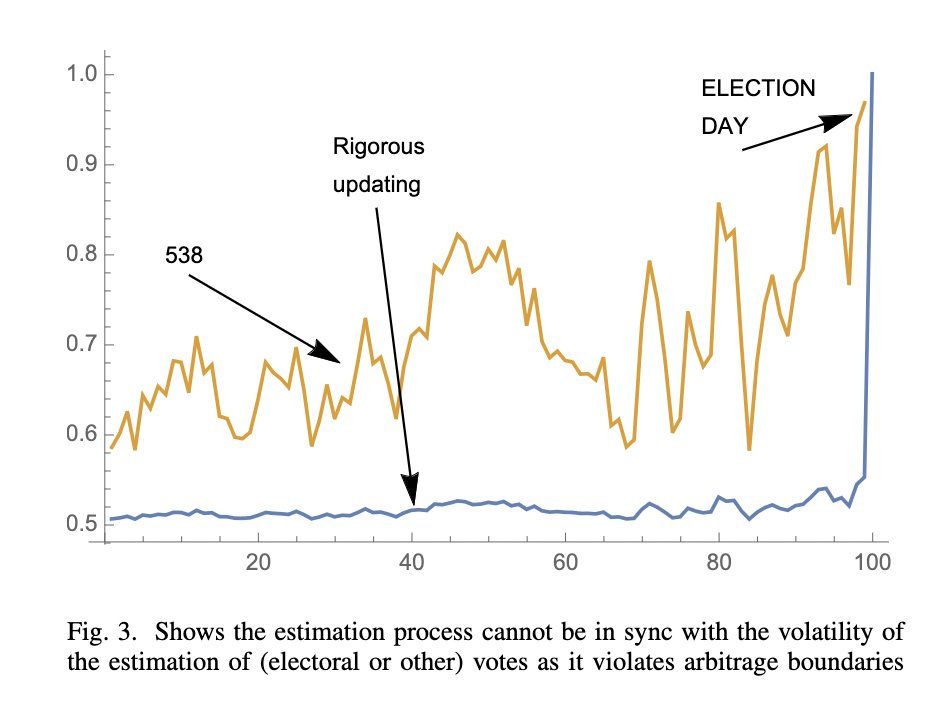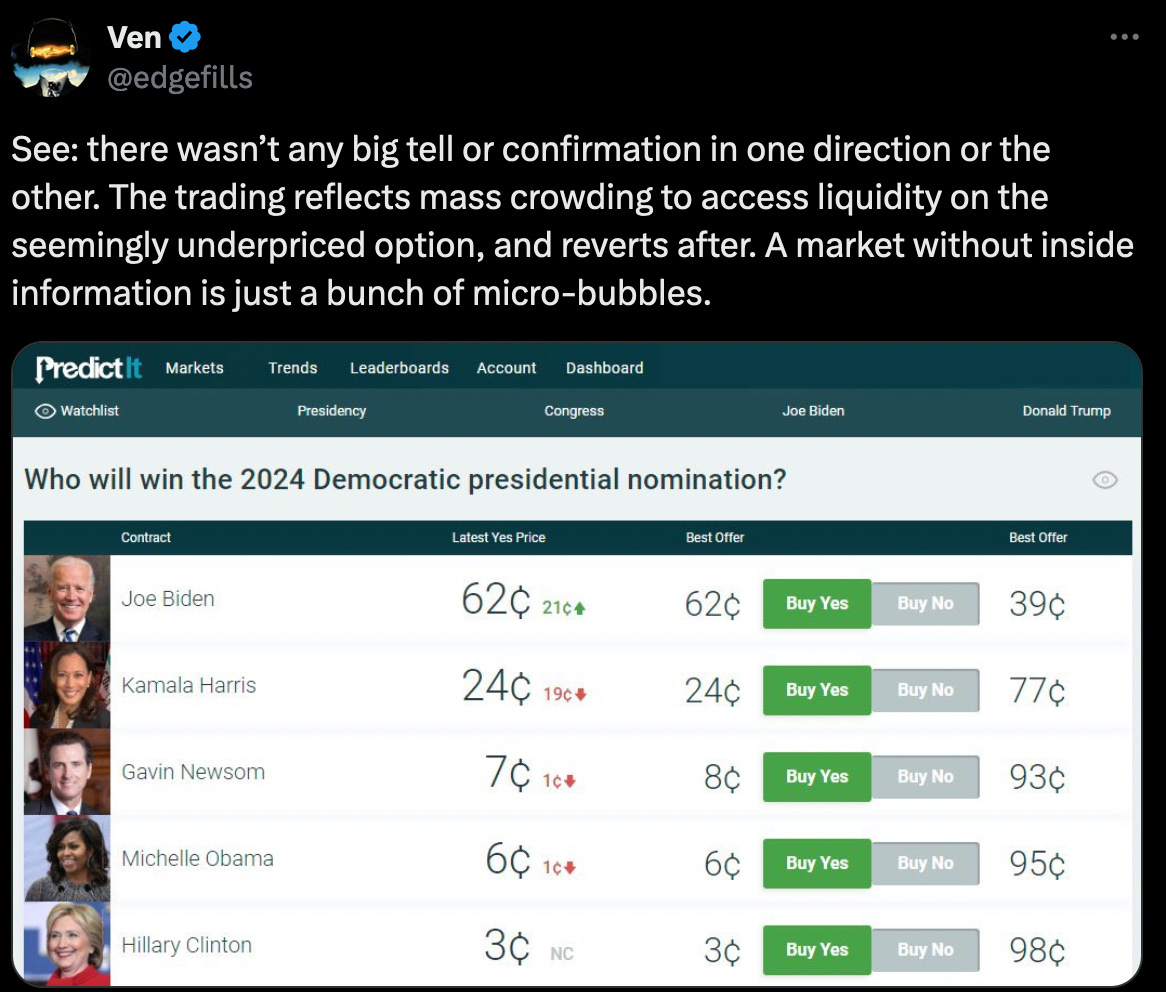Parasocial Activity
On predi(le)ction markets
Back when I enjoyed playing poker, I was a huge fan of prop bets, particularly a game called Lodden Thinks. (You can tell I was just too young for the poker boom, but precisely the right age to religiously follow the original run of Poker After Dark.)
The rules are pretty straightforward — two players at the table agree to be counterparties. One of those players asks a third party (C) a question — let’s say, “how many calories are in a pint of Guinness.” Once C has “locked in” an answer in their head, the counterparties start bidding on what C’s answer is rather than the actual number of calories itself. So player 1 might bid that C thinks there’s 150 calories in a pint. Player 2 can either take the under, or propose a higher line. After a line has been set, C reveals their answer, and the player who took the correct side wins the prop bet.
You can hear the full story from Phil Laak, one of my favorite players due to his nickname “Unabomber” (of course), before I started hating everyone who wears a hoodie and sunglasses that sits down at a table. I like the chatting, man, take off the earphones.
On a larger scale, this is all a prediction market is. A binary option is created around an event outcome, and people seek liquidity to speculate on it and consume it at the price and quantity that they desire. This doesn’t imply anything about the “true probability” of the event, because the event is inherently an n=1 outcome (otherwise you couldn’t have a binary resolution, of course.) All you are seeing when a prediction market fluctuates is the predilections of the people entering and exiting the trades in real time. What on earth does this imply about the true likelihood of the event occurring, unless there is an asymmetric information edge present, in which case the liquidity would drop off rapidly and the price shoots to one resolution band or the other?
(For more on how information asymmetry is a necessary part of a functioning market, you can see my insider trading longform A Little Dark Edge.)
It’s interesting that the only accepted politically correct binaries in discourse nowadays are options, because when I was first trading, it was basically impossible to trade them as retail. (I would later learn that the institutions called them “digital” post-2008 because of the connotation between “binary” and “gambling”.) I definitely believe in hyper-accurate prognosticators — I mean, how could I not, given how I write and talk — but it particularly grinds my gears as to how much this has leaked into media and general discourse. The prediction market fluctuations don’t mean anything! Nor do the unfalsifiable floating probability models! From July 2024 (but frankly, I’ve been ranting about this for just under a decade now):
On the topic of elections, as I’m wont to say, I consider them binary options. The delta sensitivity to an event this far out is not meaningful. “Polls predict other polls” is my mantra, and I disregard them up until roughly where theta decay ramps up for an option (~2-3 weeks out.)
I don’t think prediction markets are useful either. In a purely uncertain market, the price of an outcome is simply the equal division of the sample space. Nobody has any true inside information in this situation, and there isn't one D decision maker with significant weight to overrule Biden, so odds will converge to somewhere around 1-(trump odds)/2, accounting for Biden’s incapacitation/death probability.
Lo and behold, when did the odds start actually diverging from 50/50 in volume?
Anyone who tells you that they can model a complex n=1 event to a high degree of accuracy is full of shit. Full stop. The best election model, unless something is truly obvious (see: Obama/McCain), is 50/50 — either it happens or it doesn’t, then you look for an entry on the side you think wins. (Of course, this isn’t true for smaller scale elections where it’s far easier to extrapolate from anecdata or more accurately bootstrap a representative voting sample.)
Yes, I’m well aware of these “pushing the market” “muh French quant” news stories. It’s all bullshit. Journalists need something to write about. A sized bet just means that someone has a risk tolerance in that size (or is laying off action, it’s truly impossible to know what people’s exposure actually is short of 13-F disclosures.) Some people like to bet big. Some people like to bet often. This market implies nothing at face value about the “odds” of winning a state, and it highlights how mathematically illiterate most discussion is that people treat fluctuating probabilities as an actual data point. Only the presence of informed trading can give signal as to the likelihood of an outcome.
But, of course, this is dissatisfying. We obviously can’t treat everything as a coin flip, it simply doesn’t make sense as an optimal model, or it turns into comic book material:
In the original 1952 comic book, Donald Duck meets the eccentric Professor Batty, who persuades Donald to make decisions based on flipping a coin at every crossroad of life:[5] "Life is but a gamble! Let flipism chart your ramble!" Donald soon gets into trouble when following this advice. He drives a one way road in the wrong direction and is fined $50. The reason for the fine is not his bad driving, but rather the fact that he relied on a coin to do his thinking instead of deciding for himself.
It is obviously not a coin flip each time Aaron Judge comes up to the plate as to whether or not he hits a home run. But that’s the thing about probability (and statistics, as I repeat so often) — it’s an approximate given a potential distribution of outcomes, not an implication as to the likelihood a single event breaks a specific way. Pray tell, what exactly does “Donald Trump, as of September 7th, has a 65% chance to win an election on November 5th” even mean? How could you possibly validate this model in any coherent way? This is the inherent problem with polls and models built off of polls in general:
a) there’s no good way to bootstrap a truly representative sample
b) any steps taken to extrapolate that amplifies any noise in the raw polling data
c) as a result, there’s no good way to “massage” the output to look “realistic” because it’s inherently an unfalsifiable output
In trading systems, we can test our models with PnL. (In fact, I’m a very, very big proponent of live testing rather than backtesting for this reason. It takes me a couple trades tops to figure out if a model is just wrong.) And as a trader, even though I tend to be extremely accurate relative to the norm, I never let my profitability hinge on the end result. You don’t want to wait until the end, which is why zero-day trading is the most dangerous game (which you can read more about in What’s the Deal with Zero Days?)
How do you test the accuracy of a polling model that churns out floating probabilities for months on end? How fucking embarrassing is it for this vaunted model to just end up at 50/50 give or take after all those bloviating blog posts in the end anyway?
I’m often reminded of this comic from the 2017 spat between Taleb and Silver that helped me formalize the “elections as binary options” idea:
I have no problem with people speculating on outcomes, but the degree to which narratives are being laundered through these markets has been particularly alarming and grating this time around. It’s the perfect snake oil, and it’s just gone way too far. What should be a fun tableside prop bet or bets made “for the bantz” is now driving discourse nonstop and it’s just so moronic to the point where if I comment on this any more, I’ll probably find myself rocking back and forth in a strait jacket mumbling “unfalsifiable probabilities don’t imply anything about the true odds of an outcome” over and over again in a padded room by 2028.
(There’s more I could say about how the lack of ability to short vol on a european binary option is precisely what makes these “prices” so unreliable at implying a probability, but that’s probably beyond the scope of the target audience. If you want to read more, you can check the original Taleb paper that I borrow the graphic from all the time for more concrete math.)
National politics is largely a game that generates depression and rage through kayfabe to drive engagement and encourage ad spending, and the new meta of discussions between the retail punters and journalists that stare at these “prices” and “probabilities” nonstop always devolves into some variant of the quarrel between Ivan Ivanovich and Ivan Nikifirovich, where years down the line, they’ll each still be convinced that there’s some quantitative methodology that will definitively prove their trade right, irrespective of profit or loss, when it’s inherently unfalsifiable. It is a depressing world, gentlemen!
If you’re sick of prediction market charts and would rather play some Lodden Thinks, feel free to share this with a friend or forward the email.







